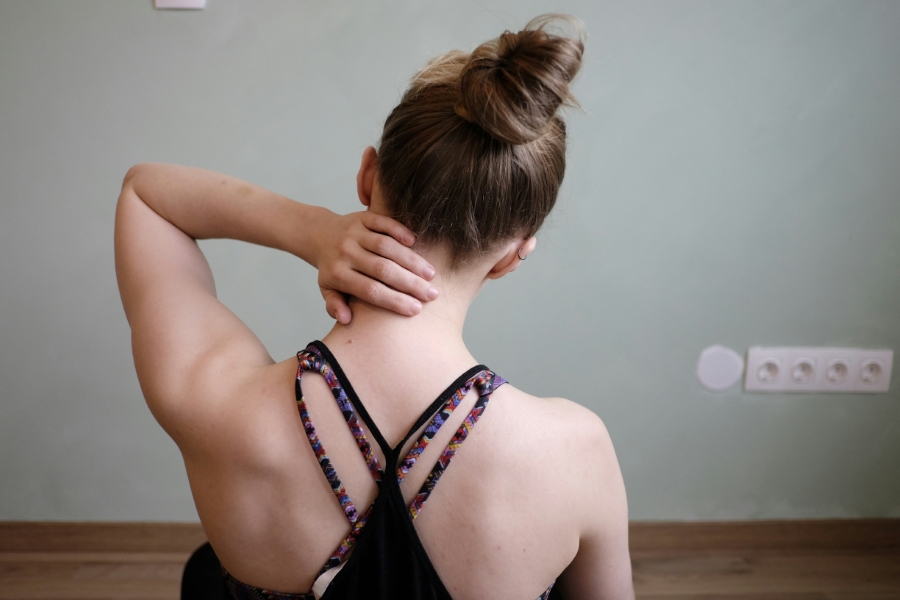
Neck pain is a common problem for many people. This article explores if physical therapy can really help. We’ll look into what causes neck pain, how physical therapy works, and the benefits it can bring.
First things first, let’s understand how physical therapy can be helpful for neck pain by understanding the root cause of the issue.
Causes of neck pain
To embark on a journey toward effective neck pain management, it is essential to delve into the roots of this common ailment. It can manifest itself from various origins, each contributing to the intricate tapestry of discomfort.
Poor posture
One prevalent contributor to neck pain is poor posture. Prolonged periods of sitting or standing in awkward positions can exert undue stress on the neck muscles and spine, leading to discomfort and pain. Even for those who enjoy a healthy routine, disruption to the schedule, such as traveling or conference attendance can lead to temporary problems that result with pain.
This is why it’s important to find a way to keep your healthy habits even when it is less convenient to do so, by finding a low-cost solution that works even under different circumstances.
Muscle strain
Another factor that frequently plays a role in neck pain is muscle strain. Overexertion, abrupt movements, or sustained tension on the neck muscles can result in strains, causing pain and stiffness.
Injuries
Injuries, whether acute or chronic, can significantly impact the neck. Trauma from accidents, sports-related incidents, or falls can lead to injuries that trigger persistent neck pain.
As we navigate the landscape of causes, it becomes evident that these factors are not isolated; rather, they often intertwine, creating a complex web of discomfort.
Statistical insights on neck pain
Looking at the numbers, we see that many people worldwide experience neck pain. The statistics show how much it affects people, whether from lifestyle, work, or unexpected accidents. The global epidemiology of neck pain brings about biological and psychological risk factors associated with the initiation and progression of the problem.
This data of the study lined above emphasizes the importance of dealing with this issue, as it affects 28 people from a population of 1000, which makes it a common problem.
Building the foundation for managing neck pain

Looking at the different reasons for neck pain helps us understand it better and find ways to manage it. Customizing treatments based on what causes each person’s pain is important. This is especially important when considering how physical therapy can help manage it overall.
To sum up, knowing the various causes of neck pain is crucial for making good decisions. By recognizing the different factors and looking at the numbers, we set the stage for understanding why specific treatments, like physical therapy, are essential for dealing with and easing neck pain.
Understanding Physical Therapy for neck pain
Physical therapy is an important part of helping people get better. It’s a structured way to heal and improve how our bodies work. Physical therapy can be really helpful in dealing with the main reasons for neck pain. This part explains the basic ideas behind physical therapy and its importance in healthcare.
Benefits of Physical Therapy for Neck Pain
Getting relief for neck pain often involves physical therapy. This is where personalized treatments and specific exercises come together to help. Let’s look into how physical therapy can benefit those dealing with it.
Tailored interventions
Physical therapy isn’t the same for everyone; it’s a personal journey for relief. Therapists use different exercises and techniques designed for each person’s specific challenges. This personal approach makes sure the treatment matches what each patient needs.
Targeted stretches
A crucial part of physical therapy for neck pain is doing specific stretches. These gentle and exact movements help ease tension, increase flexibility, and make muscles work better. By focusing on the exact muscles causing neck discomfort, these stretches help bring back balance and comfort.
Tailored exercises
In addition to stretches, specific exercises are essential in physical therapy. These exercises aim to strengthen weak muscles, improve stability, and fix imbalances causing neck pain. Because these exercises are personalized, they help slowly and steadily improve the overall health of the neck.
Spectrum of interventions
Physical therapy is like a complete toolkit, providing different ways to help with neck pain. This includes moving techniques, exercises to fix posture, and therapeutic methods. Each plays an important role in the overall plan to relieve pain in many ways.
Manifold benefits
People gain many benefits from doing physical therapy for neck pain. One big advantage is better movement—patients often can move their necks more and become more flexible. Another important benefit is less pain; the exercises reduce discomfort and make daily activities more comfortable.
Preventive measures
Physical therapy isn’t only for easing pain but also for preventing future problems. By dealing with underlying issues and imbalances, physical therapy helps stop future neck problems. It gives people the knowledge and tools to keep their necks healthy in the long run.
Holistic solution
In simple terms, physical therapy is a complete solution for neck pain. It does more than relieve symptoms; it brings back balance, function, and overall well-being. The personalized and targeted physical therapy approach makes it a transformative journey for long-lasting relief from neck pain.
As we explore how physical therapy helps, it’s not just a list of benefits but a guide to a life without accepting a list of limitations. It’s a journey towards better movement, less pain, and a proactive approach to prevent future issues—a journey guided by physical therapy with care and precision.
Tips and exercises for dealing with neck pain

Certainly! Here are some simple neck exercises that may help alleviate neck pain. Remember to perform them gently, and if you experience increased pain or discomfort, it’s advisable to consult with a healthcare professional.
Neck tilts
Sit or stand with your back straight.
Slowly tilt your head and bring it to one side, with your ear towards your shoulder.
Hold for 15-30 seconds, feeling a gentle stretch on the opposite side.
Repeat on the other side.
Neck turns
While sitting or standing, slowly turn your head to one side.
Hold for 15-30 seconds, feeling a stretch in your neck.
Return to your hand to the center and gently repeat the same but on the other side.
Neck flexion and extension
Gently lower your chin down, but not inwards, and towards your chest, feeling a slight stretching sensation at the back right around the top of your neck.
Hold for 15-30 seconds.
Slowly lift your head and bring it back up, as you are holding your sight steady – continue until you are looking towards the ceiling.
Hold for another 15-30 seconds.
Shoulder rolls
Roll your shoulders slightly forward, and perform a steady circular motion for 10-15 seconds.
Then, roll them backward for another 10-15 seconds.
This helps release tension in the neck and shoulders.
Neck resistance exercise
Place your hand against your forehead.
Push your head forward while resisting with your hand, engaging the neck muscles.
Hold for 5-10 seconds.
Repeat the process by placing your hand against your head and resisting backward.
Neck retractions
Sit up straight and gently tuck your chin in towards your chest.
Hold for a few seconds, feeling a stretch at the back of your neck.
Repeat several times.
Side-to-side head movement
Slowly tilt your head to one side, bringing your ear towards your shoulder.
Hold for a few seconds.
Return to the center and tilt to the other side.
Repeat several times.
Levator scapulae stretch
Begin in a seating or standing position and slightly and gently tilt your head to one side.
Then carefully place a hand on the same side but behind your back.
Hold this position for up to 30 seconds, as you feel a stretching sensation along the side of your neck.
Then gently repeat on the other side.
Neck relaxation exercises
Practice deep breathing and gentle neck rotations to encourage relaxation.
Inhale deeply, and as you exhale, turn your head to one side, then the other.
Continue for 1-2 minutes.
Remember, consistency is key, and listening to your body is crucial. If the pain begins to worsen, or even if it remains constant, don’t hesitate to consult with a healthcare professional.
When to seek professional help for neck pain?

Recognizing the right time to seek professional guidance, including services like Physical Therapy, is imperative. We talked with our friends over at Scripps Ranch in San Diego who helped us understand this problem with all of its accompanying nuance. Dr. Matthew, Dr. Kevin, and Dr. Jina helped us navigate this topic better, sending me relevant literature on the topic, and sharing their expertise through a short conversation. This is how I was able to delve deeper into the topic and outline specific scenarios wherein individuals should consider consulting a physical therapist for their neck pain.
Emphasizing the importance of timely intervention, this guide helps people make informed decisions about when to transition from self-management to seeking expert advice. Whether you’re in Scripps Ranch or beyond, understanding the signs that necessitate professional assistance ensures comprehensive care for your neck pain.
What should you do with neck pain?
This exploration highlights the integral role of physical therapy in managing and alleviating neck pain. Summarizing the key insights discussed throughout the article, we leave readers with a clear understanding of the benefits and practical considerations associated with incorporating physical therapy into their neck pain management strategy. The invitation is extended to consider physical therapy as a viable and effective option on the journey to a pain-free and mobile life. As we navigate the complexities of this problem, the empowering potential of physical therapy emerges as a beacon of hope for those seeking lasting relief.